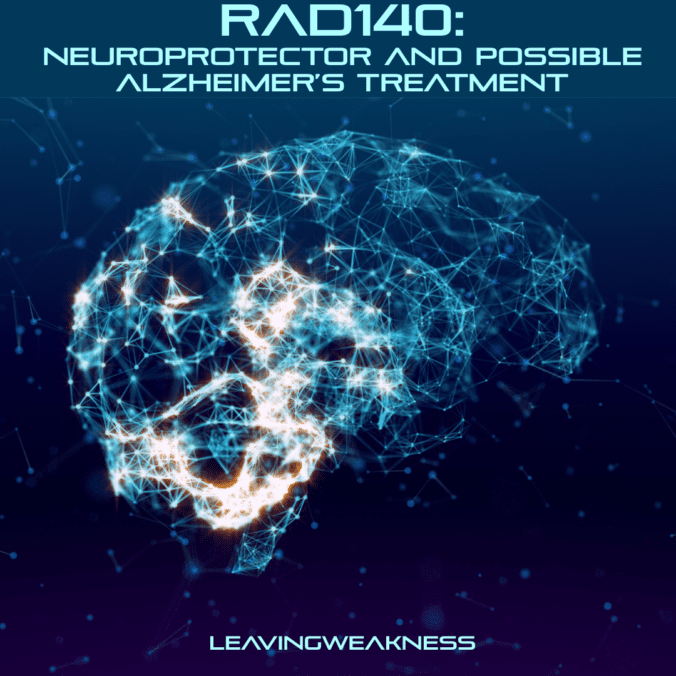I’ve taken Rad140 (Testolone) for years now and ran several cycles of it. It’s my favorite sarm for sure because it has the highest anabolic ratio of 90:1, So it’s almost purely anabolic. To put it into perspective, consider that Ostarine’s A:A ratio is only 3:1 and LGD4033 is 10:1. I covered the fat burning and muscle building properties of Rad140 in this article.
But there is another reason I suggest this one that many people haven’t realized. This is the cognitive effects that many researchers experience with this compound.
With chemical science, we often hear talk about unusual effects people notice while using something. Then, you wonder what the hell that’s all about and have sum it up to broscience because there is no literature to support any science behind such claims. Often times scientific info rolls out years later to support that broscience as being based in actual science.
There have been dozens of folks that mention an increase in mental focus when using Rad140. I personally have experienced this as well. But there is actually some recent research that’s come out that may explain why.
RAD140 AS A POSSIBLE TREATMENT FOR ALZHEIMER’S.
Alzheimer’s disease currently has no cure, which means that the progression of the disease is inevitable. This also means that neuronal death is also inevitable. This creates a vicious cycle of proteins and plaques killing brain cells and scientists are trying to find a solution. Fortunately, RAD140 might provide the protection the brain needs as studies heavily suggest it may be useful in the prevention of Alzheimer’s and other neurodegenerative disorder-related cell death.
A primary theory behind the progression of Alzheimer’s is the accumulation of amyloid beta plaques and tau protein tangles, which interfere with cellular transmission and result in brain cell death.
Research suggests that androgens might play a role in the progression of Alzheimer’s disease. This means that targeting androgen receptors early might help treat or prevent the disease. Studies indicate low testosterone had been present in the brain both during and before clinical diagnosis of Alzheimer’s. This strongly strongly suggests androgens playing a role in treating diseases like Alzhiemer’s.
Testolone as a neuroprotective compound
Rad140 interacts with the androgen receptors in the brain and may be repairing cognitive damage and may be soon labeled as a neuroprotective compound!
In a recent study, scientists studied RAD140 in rat brains for its ability to provide neuroprotection for the brain to protect itself against neurodegenerative diseases. This is likely the explanation behind why so many researches experience nootropic like effects with this compound!
Understanding these studies can be very cumbersome if you don’t posses a background in science. This is why reached out to my good friend, biochemist Christopher Ward that runs the website www.radical-research.com to help transpose the data to an understandable level.
Understanding the Rad140 Alzhiemer’s studies
Here are biochemist Christopher Ward’s interpretation of the information in the studies:
RAD140 was equally as effective as testosterone in protecting hippocampal neurons against induced cellular death. This is important because the Hippocampus is a complex brain structure that has a major role in learning and memory.
The mechanism of this function was dependent upon Mitogen-activated protein kinase (MAPK) signaling as RAD140’s neuroprotection was inhibited by the coadministration of a MAPK inhibitor. RAD140 was also able to protect rat brains against neurotoxicity of the potent neuroexcitatory compound kainic acid.
In an androgen deficient rat model, RAD140 produced tissue specific androgenic action without a negative impact on the prostate. Androgenic effects were apparent in the brain.
Androgen deficient rats, which had been castrated, showed a decrease in androgen receptor content in the brain. This is important because androgens are involved in the organization and function of the central nervous system. RAD140 displayed activation of androgenic gene regulation effects in those androgen deficient rat models.
The findings in the studies demonstrate initial preclinical efficacy of a SARM in neuroprotective actions relevant to Alzheimer’s disease and related neurodegenerative diseases.
Interesting Findings
So there is actually some real science to back up some of the nootropic like effects researchers are making claims about. However, these studies have only been conducted in lab rats and cannot yet be deemed a viable treatment for cognitive diseases. However, there is amazing potential here that I wanted to bring to the attention of the research community.
If you are interested in researching Rad140, then check out my preferred source for sarms by clicking HERE.


Leave a Reply